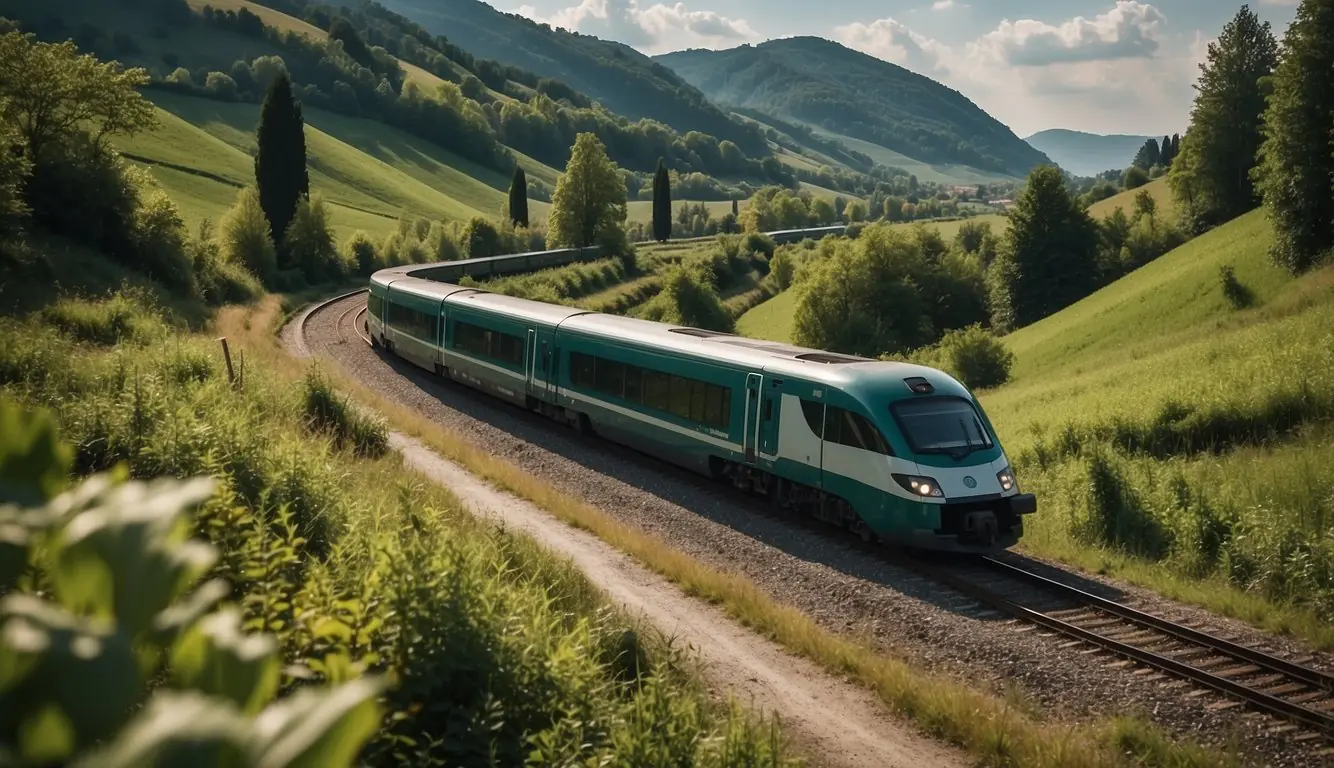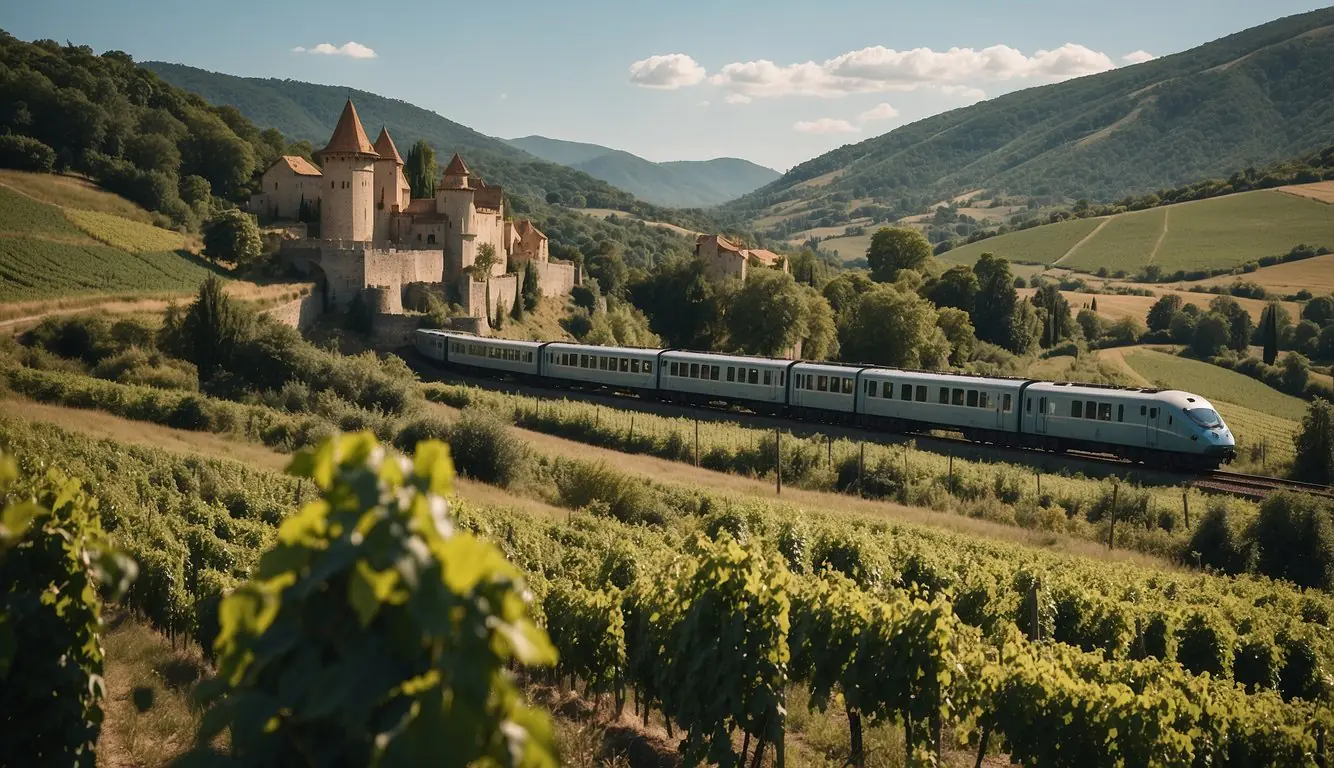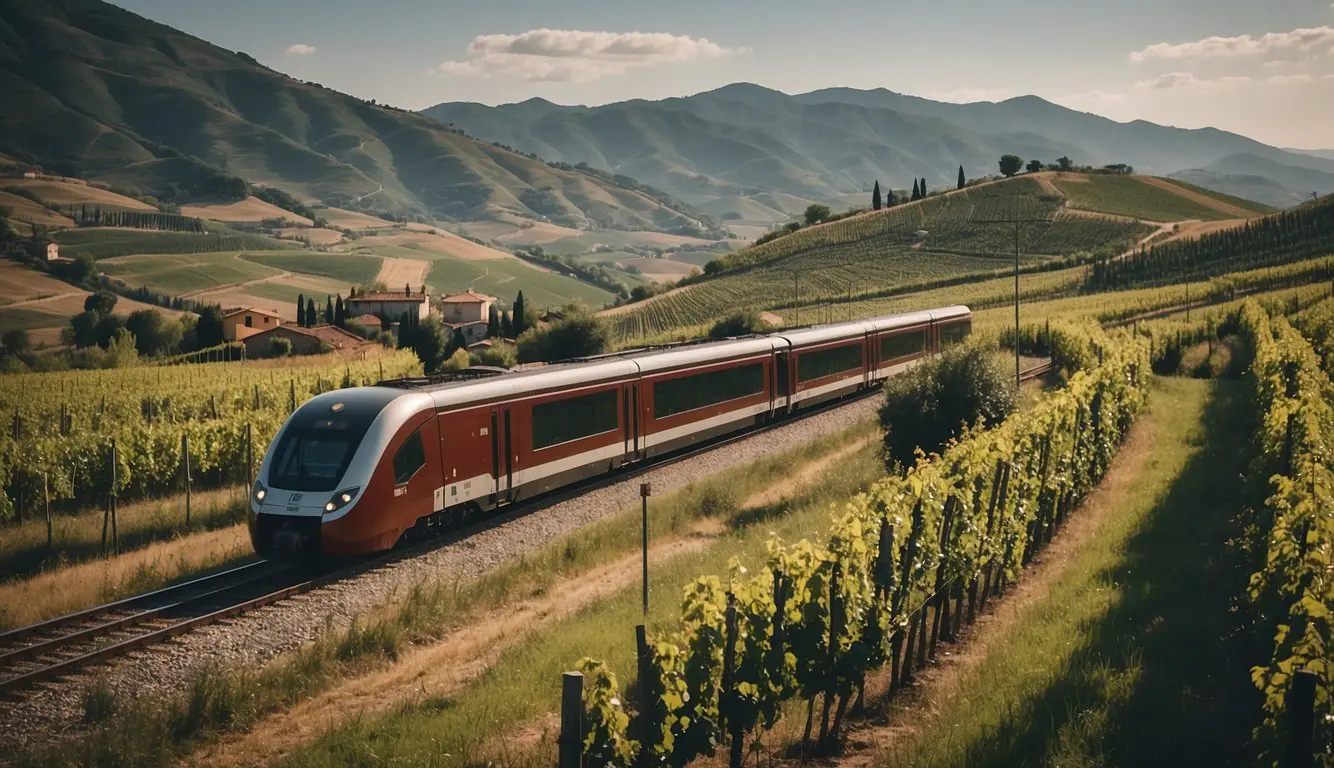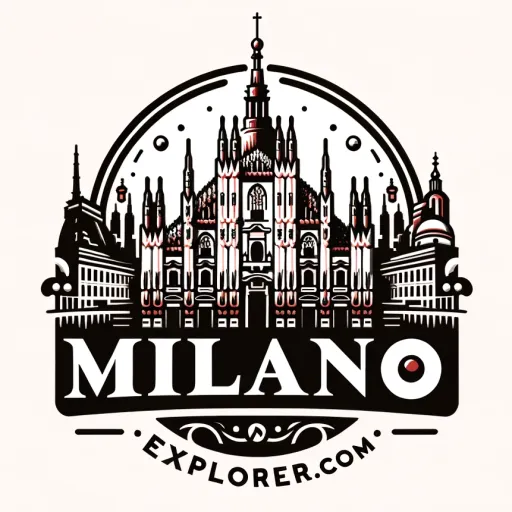Set against the backdrop of Italy’s fashion capital, embarking on day trips from Milan by train offers a taste of the region’s diverse landscapes and rich cultural tapestry.
With Milan’s central location in Lombardy, a network of efficient trains connects the city to a multitude of destinations, each promising a unique experience.
Whether it’s the allure of shimmering lakes, the charm of historic towns, or the majesty of the Alps, these journeys reveal the hidden gems that lie just a short train ride away.

Our adventures begin at Milan’s bustling train stations, gateways to Northern Italy’s cultural highlights and tranquil escapes.
From here, we can head to Lake Como, known for its exquisite villas and celebrity allure, or opt for the romantic cityscapes of Verona.
As a nexus of art and fashion, Milan is a starting point not only to explore Italy’s prestigious design hubs but also to traverse through time in cities enriched with history and heritage.
Day trips from Milan by train
Key Takeaways
- Train travel from Milan provides easy access to Northern Italy’s diverse attractions.
- The region excels in cultural experiences, offering art, fashion, and history.
- Day trips enable varied exploration, from serene lakes to vibrant, historic towns.
The Rich History of Lombardy

Lombardy, a region rich with culture and history, offers an abundance of architectural marvels and stories from the past.
We will explore the profound impact of the Renaissance and the region’s medieval heritage that has left an indelible mark on this part of Italy.
Renaissance Influence in Milan and Beyond
The Renaissance period was a time of great cultural flourishing in Lombardy, with Milan at its heart.
Milan’s Duomo di Milano is not only a testament to architectural grandeur but also to the Renaissance influence that swept across the city and its surroundings.
A stunning example of this is the Certosa di Pavia, a monastic complex that showcases a fusion of Gothic and Renaissance styles.
Renowned for its intricate facade and the beautifully detailed interior, this historical site remains one of Lombardy’s most treasured landmarks and is recognized on the UNESCO World Heritage List.
Medieval Architecture and UNESCO Sites
Lombardy’s history is also deeply rooted in the Medieval era, which can be seen in its numerous castles and fortifications.
The region hosts several sites honored on the UNESCO World Heritage List, such as Santa Maria delle Grazie, housing the iconic Last Supper painting.
Nobility and religious fervor led to the creation of impressive medieval structures throughout the region.
One cannot overlook the importance of Lombardy as a central point for monastic life.
The Certosa di Pavia, once again, stands as a significant monastic complex from this period, offering insight into the lives and culture of the monks who once lived there.
Our journey through Lombardy’s rich history is not only about appreciating timeless art and architecture; it’s about understanding the influence that this region had on shaping the cultural landscape of Europe during some of its most transformative periods.
Cultural Highlights of Northern Italy
Northern Italy is famed for its rich tapestry of art and cuisine, offering an array of cultural experiences within a short train ride from Milan.
From the Gothic spires of Milan’s cathedral to the culinary delights of Emilia-Romagna, each city is a gateway to the region’s heritage.
The Artistic Cities and Their Offerings
Milan remains at the heart of Northern Italy’s cultural landscape, home to the iconic Duomo di Milano, a masterpiece of Gothic architecture.
Venturing out, the ancient streets of Bergamo boast well-preserved medieval structures, while Pavia is celebrated for its historical university and the Visconti Castle.
Nearby, Cremona is intertwined with musical history, known for its violin-making tradition.
Cuisine and Gastronomy of the Region
Beyond the marvels of art, the gastronomy of Northern Italy is a testament to its cultural richness.
Turin is not just a cultural hub but also the birthplace of bicerin, a traditional Italian coffee beverage.
Similarly, Bologna and Modena are culinary giants, where one can indulge in authentic pasta dishes and balsamic vinegar that have defined Italian cuisine globally.
The region is also the cradle of beloved Italian products such as Parma ham and Parmesan cheese in Parma, and pizza which, while not originating here, is perfected in many Northern Italian towns.
The lake town of Como and the port city of Genoa also offer unique contributions to Italian food culture with their own distinct flavors and recipes.
Exploring the Italian Lakes
Just a short train ride from Milan, the Italian Lakes offer stunning landscapes with charming towns dotted along their shores.
Each lake has its unique allure, with opulent villas, lush gardens, and panoramic views that make for unforgettable day trips.
Lake Como and Its Iconic Towns
Lake Como is renowned for its dramatic scenery set against the foothills of the Alps.
We can take a train to the town of Como, which takes approximately 40 minutes. Como is a gateway to the lake’s numerous delights, including the town of Bellagio, often referred to as the pearl of Lake Como.
A boat trip leads us to Varenna, a picturesque village where visitors can explore Villa Monastero and Villa Cipressi.
For those looking to see magnificent gardens and intricate architecture, Villa Melzi d’Eril in Bellagio is a short ferry ride away.
- Train to Como: approx. 40 minutes from Milan
- Boat to Bellagio and Varenna: regular services available
- Visit:
- Villa Monastero: historic villa with a botanical garden
- Villa Melzi d’Eril: famed for its gardens and lakefront views
The Charm of Lake Garda and Maggiore
Lake Garda, Italy’s largest lake, is easily accessible by a train journey to Desenzano del Garda or the medieval town of Sirmione, known for its thermal springs and the imposing Scaligero Castle.
Lake Garda has a rich offering, from cultural sites to wineries.
Not too far from there, Lake Maggiore invites us to the town of Stresa, where we can embark on a boat to visit the Borromean Islands with their palaces and extravagant gardens.
From Stresa, the train journey back to Milan is roughly an hour, making it a convenient yet culturally rich day trip.
- Train to Desenzano del Garda: approx. 1 hour 30 minutes
- Train to Stresa: approx. 1 hour
- Boat trips: available to the Borromean Islands and Lake Garda towns
- Key attractions:
- Scaligero Castle in Sirmione
- Villa Carlotta: historical villa with art collections and botanical gardens
Day Trips and Short Journeys
We know that Milan is a hub of fashion and culture, but just a train ride away, one can discover an astonishing variety of experiences.
From picturesque towns to the allure of vineyard tours, the vicinity of Milan offers a treasure trove of day trip adventures accessible by train.
Picturesque Towns and Lesser-Known Gems
We’re often drawn to the scenic beauty of Lake Como‘s towns such as Bellagio, Varenna, and Tremezzo.
Rich in history and charm, these towns offer us a glimpse into the luxurious lakeside living with grand villas like the famous Villa d’Este.
For a step back in time, the medieval town of Bergamo captivates us with its cobblestone streets and Venetian walls, whereas the Certosa di Pavia is a majestic monastery that showcases the beauty of Renaissance architecture.
- Bellagio: Often referred to as the ‘Pearl of Lake Como’.
- Varenna: A quiet fishing village with delightful walkways.
- Tremezzo: Known for the astonishing Villa Carlotta.
- Bergamo: Split into two distinct parts – the historic upper city and the modern lower city.
- Certosa di Pavia: A symbol of grandeur with its intricate facades and art.
The Wine Regions and Culinary Excursions
We can’t help but be enchanted by the rolling vineyards of regions like Franciacorta and Piedmont, where the art of wine-making takes center stage.
The Franciacorta region is renowned not just for its wine but also for an array of local produce that tantalizes our taste buds. Meanwhile, Piedmont ushers us into the world of prestigious truffles and Barolo wines.
Take a day trip from Milan to the city of Asti in the Piedmont region, to dive deep into a rich wine heritage.
For a robust culinary journey, Lugano presents an interesting cross-border trip, blending Swiss sophistication with Italian flavors.
And for those of us longing for coastal serenity, a day trip to Portofino in the Liguria region offers not just stunning sea views but also an exclusive peek into Italian Riviera living.
- Franciacorta: A sparkling wine region offering guided wine tastings and tours.
- Piedmont: Famed for its culinary specialties and red wines.
- Asti: Celebrated for its Spumante and Moscato wines.
- Lugano: Sits pleasantly near Lake Lugano, a blend of Mediterranean flair and Swiss elegance.
- Portofino: A luxuriant seaside village where we find scenic harbors and artisan shops.
Art and Fashion Nexus

In the heart of Northern Italy, Milan serves as a pivotal hub where artistry and haute couture converge. Here, we uncover the interconnectedness of Milan’s artistic heritage and its status as a fashion powerhouse.
Milan as a World Fashion Capital
Milan is renowned as one of the world’s fashion capitals where prestigious designer brands such as Armani, Prada, and Versace enthrall style enthusiasts.
The illustrious Galleria Vittorio Emanuele II stands as a historic testament to both luxury shopping and architectural splendor, its galleries brimming with the confluence of fashion and opulent design.
A journey by train to this stylish metropolis isn’t only about the clothes; it’s an encounter with fashion’s enduring influence on local culture and economics.
Art Movements and Galleries
Vibrant art scenes are woven into Milan’s cultural fabric, from celebrated works of the Renaissance to the decorative allure of Art Nouveau.
Our exploration of art transports us to galleries like the Pinacoteca Tosio Martinengo, showcasing classic masterpieces alongside modern statements.
Moreover, the esteemed Royal Palace of Milan houses exhibitions that narrate Milan’s artistic evolution. In these spaces, the brush strokes of legendary artists such as Canova and Hayez reflect the city’s historical depth and radiant creativity.
Conclusion
We have discussed various day trips from Milan that cater to diverse interests, from historic cities to natural wonders.
Milan’s central location and efficient rail network allow us to visit picturesque lakes, medieval towns, and bustling markets with ease.
- Lake Garda and Verona: A trip to Lake Garda offers us stunning landscapes and delicious DOC wines. In under two hours, we can find ourselves sipping Lugana by the lake.
- Cinque Terre: The coastal beauty of Cinque Terre is unmatched, with vibrant villages and sea views. Although a guided tour is advised due to the lack of a direct train, the journey is well worth the effort.
- Swiss Alps: For adventure seekers, the Bernina Express route to Alp Grüm is breathtaking, connecting us directly with the Swiss Alps’ majesty.
Our exploration of Northern Italy’s cultural and culinary delights is easily accessible from Milan.
Bolognese in Bologna or a Florentine steak in Florence; these experiences are all within our reach.
Remember, the key to a successful day trip is planning—checking train schedules and booking tickets in advance can save us time and hassle.
Our excursions from Milan by train promise enriching experiences, each with its unique flavor and charm, inviting us to immerse in the region’s abundant offerings.
Frequently Asked Questions
Before planning your train adventures from Milan, it’s practical to know which destinations are both accessible and worthwhile.
We’ve gathered some common inquiries to help outline your day trip possibilities.
What are some popular destinations for a day trip from Milan by train?
Some of the most popular destinations for day trips from Milan include the romantic waterways of Venice, the charming streets of Bergamo, and the serene landscapes around Lake Como. Each offers a unique Italian experience not far from the bustling city.
Which nearby cities are easily accessible by train from Milan for a day visit?
For a day visit, we can easily access nearby cities like the fashion-forward Turin, the historical Genoa, and the picturesque Verona, famously known as the setting for Shakespeare’s “Romeo and Juliet.”
What are the best scenic train routes for a day trip starting from Milan?
The train route to Lake Garda offers stunning panoramas of Italy’s largest lake, while the journey to Cinque Terre reveals breathtaking coastal views as you approach the five famous villages perched along the cliffside.
Can you recommend any day trips to the Swiss Alps from Milan?
Yes, an adventurous trip to the Swiss Alps is doable from Milan. Alp Grüm, accessible from the scenic Bernina Express route, is a notable bonus location for a day trip, although it requires a bit more planning.
What are ideal day trip options from Milan during the winter season?
During winter, we can still explore destinations like the snowy town of Alp Grüm or the historic and festive markets in Trento, providing a cozy, seasonal day out.
As a tourist, how can I spend a single day exploring the city of Milan?
To enjoy a single day in Milan, focus on the iconic Duomo Cathedral, the historic Sforza Castle, and the world-renowned opera house, La Scala.
Additionally, don’t miss the opportunity to view Leonardo da Vinci’s ‘The Last Supper.’ But ensure to book tickets in advance.
